Derbyshire Chip Shops Using Beef Dripping
I was 17 before my greedy fingers made first contact with a bag of chips. When I tell people this, I'm overwhelmed by the kind of outpouring of sympathy and righteous indignation that might greet the announcement that I'd never visited the seaside, or received a birthday present – the general consensus seems to be that my parents neglected their patriotic duty by failing to wean me on the great British chip.
The truth is, growing up in the 1980s, I was more than familiar with the desiccated 'wedge', and on occasion was even lucky enough to sample the pallid delights of the local Wimpy bar. But, as I've since realised, these were mere paltry apologies for the real thing. Proper chips should be thick cut and defiantly potatoey: golden to the eye, hot and fluffy within.
Such perfection is not easily found – particularly since the inexplicable rise of the loathsome Jenga chip – but, given the simplicity of the dish, I reckon it ought to be easy enough to achieve at home. Although there are always going to be times when only a vinegary parcel from The Codfather, or a rustling pile of pommes allumettes will do, a good chip recipe under your belt is surely a friend for life.
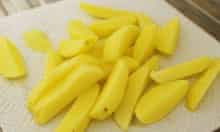
The first thing to do is choose the ingredients. As there are only two of them, this should, I think, be a breeze. I am not the first to make this mistake: "Unfortunately," chef Paul Bloxham explains bitterly, "the wrong potato will result in a guaranteed failure." Spuds divide neatly into two camps: waxy, like Charlotte and Maris Peer, and floury, such as King Edward and Maris Piper. Most recipes call for the latter, but Heston Blumenthal, who has, of course, looked into the matter with a degree of thoroughness I can only dream of, uses Charlotte or Belle de Fontenay for what he describes as "the best chips I have ever tasted". (He also recommends waiting at least a month after the crop has hit the shelves to allow the potatoes to dry out slightly, but the men at my local market aren't quite sure of the life history of their Charlottes. "Definitely had 'em for a while," one of them offers hopefully.)
As my control, I'm using a recipe developed by chef Mark Hix for the British Potato Council (pdf), on the grounds that it seems fairly standard in terms of method and ingredients and, thanks to the BPC has a pleasingly official ring to it. The potatoes are peeled and cut into 1cm thick chips. These are washed, dried and par-boiled, then drained and left to cool. The chips are then blanched in a pan or fryer of oil at 120C until soft, but not coloured, and then patted dry. At the last minute, they go back into the pan at 160C to crisp up – according to David and Si Hairy-Biker, who look like chaps who enjoy a good fish supper, double-frying is "the secret of good chips".
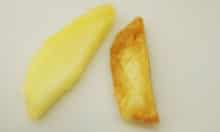
The yellow-fleshed Charlottes are already distinctly better looking after the initial frying – positively golden, in comparison with the pasty Maris Pipers. Once they've been in for a second dip, they're even more attractive, boasting a light, even tan, which makes their oddly streaky rivals look rather like the victims of a bad home-bronzing job. Despite their handsome appearance, however, they trail behind in the tasting: the Maris Pipers are soft and fluffy where the Charlottes are disappointingly dense. They also boast the delectably crunchy edges of a good roast potato.
I try another batch of the Maris Pipers with a scarily clever self-cleaning deep fat fryer lent to me by Tefal for the occasion, to see whether splashing cash on fancy gadgets can further gild the defiantly humble chip. The end results are very similar, but I find it's much easier to keep the temperature constant, and it's a relief to tell my mother she can take the fire brigade off speed dial. A fryer certainly isn't necessary for great chips, I conclude, but if you have one, it does make the process a bit simpler.
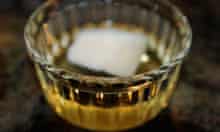
With the potatoes sorted, it's time to address the question of fat. In my experience, the best chippies usually reek deliciously of beef dripping, but Heston recommends groundnut oil as the best option, "as it is very pure and odour-free" – although, he concedes, "rendered beef … goose, or duck fat would be delicious too". Mark Hix reckons there's more to it than just flavour: "Beef dripping or lard … is the ultimate chip cooking fat because it gives a crisper, tastier result," he says, before admitting that, because animal fats burn easily, they use vegetable oil in his restaurant kitchen. I try the Maris Pipers with dripping. It's more time consuming, as it takes a while to melt, leaving me pondering the health implications of 1.5kg of solid white fat, but the results are superb – not only crisper, but distinctly tastier too.
Having established that Maris Pipers and dripping are the cornerstones of my perfect chip, it's time to turn my attention to the method. The initial preparation is fairly straightforward (wash and peel potatoes, then cut them into sizes of your choice, preferably slightly unevenly, so you end up with "a range of textures, from thicker, luxuriant, fluffier chips to more crisp-edged pieces" as Heston has it), but this rare culinary consensus doesn't last.
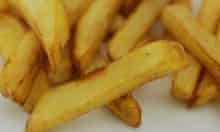
After cutting the chips, some, like Ed Baines, proceed immediately to the saucepan. Mark Hix rinses them first, while the Hairy Bikers, who are clearly prepared to invest time in the quest for the ultimate chip, suggest they should soak for "several hours – or overnight" in cold water. It's all a question of starch, according to Paul Bloxham: washing it off in this way "will help the chips cook evenly and not colour too quickly as well as ensuring a crispy exterior."
Having left some Maris Piper and Charlottes soaking in the fridge the previous evening, I'm prepared to give the Bikers' "best chips you have ever tasted" a try. They colour fast, and end up rather limp and ever so slightly soggy. Soaking, in my opinion, is not necessary – a quick rinse gives better results.
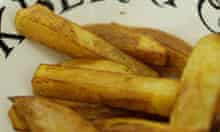
Having settled the starch issue, I'm faced with barrage of conflicting advice regarding cooking. The simplest method, as used by Ed Baines, involves a first fry at 200C, and a brief follow-up at 210C. No soaking, no par-boiling. They brown unnervingly quickly – at the end of their first cooking, they're already past WAG territory – and when I finally drain them, they're slightly al dente, despite their mahogany colouring. The fast cooking seems to have caramelised the outside, making them slightly sweet. Not good.
So far, the Mark Hix control recipe is in the lead. Heston, although advocating a similar course of action, naturally takes it one stage further by demanding the chips are refrigerated after par-boiling, and between the two fryings. "You will notice," he says "that the chips harden when chilled." He doesn't mention why this might be desirable, but the results speak for themselves – this is the crispest batch yet, suggesting that a tougher surface and cooler interior give the chip more time to develop that essential crunchy shell before it burns.
Finally, a dissenting voice. The recipe for delicious. magazine's "ultimate chips" starts off familiarly – parboiling then drying – but then veers off into uncharted territory by instructing me to pre-heat the oven to 200C and "heat the fat in a large, deep baking tray for 10 minutes". The chips are added in a single layer, and basted with the hot fat, before being baked for 35 minutes. After 20 minutes, I check on them, and discover they've begun to burn. Even after a good blotting with kitchen paper, they feel greasier in the mouth than the others, with a hard, caramelised base and a slightly soggy top. They remind me of a weird cross between roast potatoes and chips – tasty, certainly, but not quite right.
Valuable lessons learnt: for the perfect chip, you need a floury potato, a hard fat of your choice – and the patience to allow your chips to chill out between stages. Salt, vinegar and ketchup I leave up to your conscience.
Perfect chip recipe
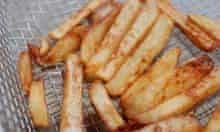
200g Maris Piper per person
Dripping or other animal fat, to cook (enough to half-fill your pan when melted)
You'll need a cooking thermometer, or electric deep fat fryer for this recipe.
Peel your potatoes and cut into chips – approximately 1cm for thick-cut chips, half that for thinner ones. Rinse well under cold water, then drain.
Put the chips into a pan of cold, salted water, and bring to the boil. Turn down the heat, and simmer until just soft to the point of a knife.
Drain, pat dry and allow to cool, then put in the fridge until cold.
Heat your fat to 120C, and add the chips. Don't overcrowd the pan. Blanch for about five minutes until cooked through but not coloured.
Remove, drain, pat dry, and refrigerate.
When you're ready to eat, heat the fat to 160C and add the chips. Cook until crisp and golden, then remove, drain, season and serve immediately.
Are you a pommes allumettes or a chunky chip person – and can you make better fries than your local chippie? Do good chips always have to be fried, and if so, what in? And finally: ketchup, vinegar – or mayo?
Source: https://www.theguardian.com/lifeandstyle/wordofmouth/2010/may/20/how-to-fry-perfect-chips
0 Response to "Derbyshire Chip Shops Using Beef Dripping"
Postar um comentário